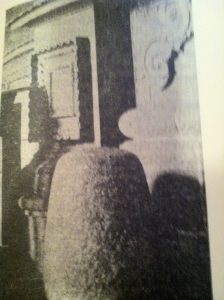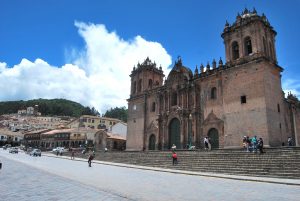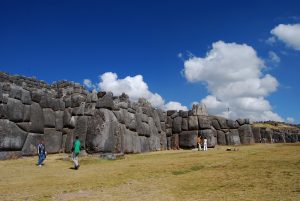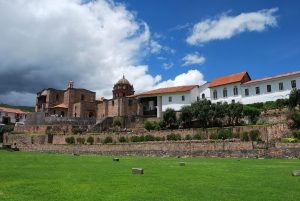Cuzco, A Sacred Place, and the Deity Viracocha

Cuzco has long been a holy city. Of course, today, its holiness is manifest in the millions of tourists who come to it, even if only as the waiting room for Machu Picchu. However for people in the surrounding area and locals it is mighty. While part of that stems from its being the seat of government and economy for the region, it also relates to the holy places and shrines in the city.
Hundreds of miles away you can visit rural communities and talk with people. If they show you their sacred places, especially the remnants of past glories, they may tell you that from them a “tunnel” goes straight to Cuzco. They will tell you they have never been to the Imperial City but that inside the earth their land is directly tied to the holy center. They will not have gone down, because to enter the earth is far too dangerous. But they swear their is a path inside the earth leading straight to Cuzco.
R. Tom Zuidema, the famous ethnohistorian and anthropologist, writes about how straight lines filled with shrines went out from Cuzco to the entire empire. He describes how the Inca would send gifts and sacrifices to people and shrines along these paths all over the Empire in enormous delegations that would traverse them. In return the people of the Empire would send offerings and gifts back to Cuzco along these lines.

Though the Empire is long gone, the lines seem to still be there in people’s minds, even if now they have gone underground.
Cuzco has many holy places, even today. Some are holy for tourist, like the “shrine” at the “twelve-angled stone”. Others are holy for Catholics and recognized by the Vatican, such as Cuzco’s many temples. But there is also a popular religiosity that stitches Catholicism together with living ideas similar to those Zuidema (or his source, the Spanish chronicler Bernabé Cobo) describes, even if the seam is not always a happy one.

One of these is underground, the laguna (pond) that people say lies under part of the Cathedral. This underground water can be seen as vital in a land where rains can fall so heavily they destroy or not fall at all as the food withers in the fields. Furthermore, half the year almost no rain falls so its coming and going is a matter of great spiritual and ritual importance for people who still depend on farming for food.

In the back of Cuzco’s Cathedral there is an altar with a figure of Jesus on it. The Christ is called the Señor of Unupunku or the Water Gate. This is the point of entry to this underground water, although the actual portal has now been blocked by the Church. People used to use it to give offerings to the cosmic water underground. They also used to take water from here and it was known for healing.
In this image of Christ Jesus is carrying the heavy cross, but to the people of Cuzco, according to local anthropologists, Jesus is seen as half submerged in the water and coming out, as if a water god.
Another Spaniard, Juan de Betanzos, gives us a hint of why this is important. He tells of how the god Viracocha, or fat lake, called people from underground waters. People came out and peopled the earth. As a result, places like Unupunku are still important because they, like water, are givers of life, whether in the composite form of a Christ or simply as a spring.
The noted Cuzco anthropologist Abraham Valencia Espinoza writes that on the site of the Cathedral, was the temple of Viracocha in Cuzco. Today tourism emphasizes the temple of the sun and the temple of Sacsayhuaman, below and above the Plaza the Main Square, with its shrines in the Cathedral.

The Spanish followed their practice of building religious buildings over the religious shrines of conquered people and built the Cathedral on top of this temple complex, whose importance is signaled by its rise above the Plaza, such that even today people have to climb stairs to get to it. Just as in the Muslim cities of Córdoba or Seville in Spain the Catholic kings of Spain had Cathedrals built on top of the great mosques, so in Cuzco they has a temple built in the same place the Incas had key holy buildings and shrines.
However, just as in Spain where these buildings hover, sometimes precariously, between being considered mosques of Christian holy spaces, the Cathedral of Cuzco rocks in tension between its indigenous heritage and its very strong contemporary Catholicism.
While today the main figure in the Cathedral is Cuzco’s patron, the Lord of Temblors, Viracocha is still there. Valencia Espinoza writes that local people consider the Lord of Unupunku to be a representation of the Lord of Temblors. In himself, as a controller of the movements of the earth, including those of water, the Lord of Temblors who only exits the Cathedral during the height of the rainy season, often to streaming water, is a representation of Viracocha.

But we do not have to go to Catholic imagery and its interpretation to find Viracocha in the Cathedral. By the Cathedral door is a large, egg-shaped stone of carved diorite. While some people say that it is simply there as a post on which to tie down the Cathedral’s door, according to Valencia, others especially older Cuzqueños and rural people see in the carving a sacred stone, a waka. They see it as Viracocha and render homage to him there, to the irritation of many of the Catholic fathers.
In any case, whether for tourists who come on pilgrimage to the seat of the great Inca Empire, and its now holy city Machu Picchu, or to locals who consider it a controller of the climate, regional state, and the economy, Cuzco continues to be a holy place. In that lies much of its attraction and mystery.




